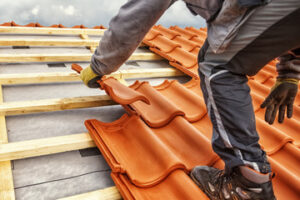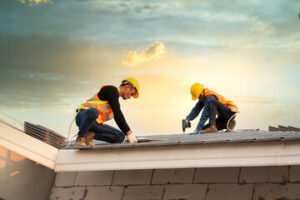A new roof is a big investment, and it can dramatically improve the appearance of your home. But there are many things to consider, from materials to installation.

Roofing contractors begin by removing any existing shingles and nails, and cleaning the work area. They should also tarp the landscaping to protect it from debris. Contact Arthur’s Roofing for professional help.
When it comes to roofs, there are a variety of materials to choose from. These range from a classic asphalt shingle to a more sophisticated architectural shingle. Each has its own benefits, and contractors must consider the cost, durability, and ease of installation when choosing which type to install.
Different roofing materials also differ in acoustic efficiency. For example, concrete tiles provide superior noise reduction, while sheet metal provides poor acoustic performance. The type of roofing material also has a significant impact on the overall look and feel of the home. A more contemporary roof may be best suited for metal or tile, while an older home can be complemented with the more traditional look of shingles.
Roofing materials also vary in their ability to resist weathering and other types of damage. For example, some roofs are self-healing while others require regular maintenance to ensure water and air are properly sealed. The choice of roofing materials should also take into account the environmental impact.
Roof materials can include a variety of materials, from the wood foundation layer to the individual shingles. Some of the most common roofing materials are asphalt shingles, slate tiles, and clay tiles. While these are popular, each has its own pros and cons. For example, slate is a popular option in New England because of its durability and longevity, but it is expensive and requires a substantial roof structure to support its weight. Concrete tiles are a more affordable option, but they can crack under heavy weight and must be resealed regularly.
Other roofing materials are membrane roofs, which consist of one solid barrier instead of individual shingles. Some of the most common types of membranes are EPDM and TPO. Membrane roofs can be fully adhered or mechanically attached. They are installed over sheathing and must be carefully flashed to protect areas around dormers, vents, and chimneys.
When installing a roof, it’s important to have the right tools and supplies to get the job done quickly and accurately. A hammer and nail gun are essential for securing the shingles, along with a utility knife to cut materials as needed. A chalk line is also useful to create straight lines, and a tape measure to help keep measurements accurate. Lastly, a roofing materials list is an important tool to help you compile your order and avoid costly mistakes.
Safety
As the old saying goes, “a little risk comes with the territory.” Roofing is not for everyone and requires a certain amount of risk to be done correctly. That said, safety is a top priority for contractors and their crews. It’s an essential part of every project and should be prioritized for the sake of the workers and clients alike.
A safe work environment starts with the basics – appropriate gear, regular inspections, and training. For example, a worker should always be equipped with non-slip shoes, eye protection, and a hard hat. A well-stocked first-aid kit and fire extinguisher are also important, especially when working with heat sources or flammable materials.
Using the proper tools and following best practices are also vital for roofers to stay safe. The job can be physically demanding, especially for inexperienced roofers. It’s a good idea for them to partner with more experienced professionals for guidance until they become proficient enough to do the work on their own.
One of the biggest risks in roof work is falling off a roof. That’s why all roofers should use a fall protection system and wear a full-body harness. Workers should also make sure to anchor their ladders securely and extend them at least three feet above the edge of the roof to avoid accidents.
Lastly, all roof openings like skylights and vents should be covered to prevent accidental falls or other hazards. These covers should be sturdy enough to withstand the weight of a person and be easily recognizable by workers. Likewise, they should be easily accessible to allow for quick emergency responses.
It’s also important to monitor weather conditions closely, especially if the work is taking place outdoors. A shift in the weather can cause dangerous situations and increase the likelihood of injuries. For that reason, all roofers should have access to real-time updates and be able to adjust their plans accordingly.
Ultimately, safety is a mindset that needs to be instilled in every aspect of the roofing process. By implementing a strong safety program and encouraging a culture of safety, contractors can safeguard their team members and clients from the dangers of roofing.
Preparation
Whether you’re in the middle of a roof replacement project or planning to have your business’s rooftop replaced, it’s essential to prepare for the work ahead. The right preparation ensures that the project runs smoothly and protects your investment.
Depending on the size of your home and the material used for the new roof, installation can take one to three days. In order to make the process as smooth as possible for you and your family, be sure to clear the area around your house and remove movable objects, such as patio furniture or plants. You should also take the time to move any valuable items out of the work zone. This will help prevent damage or theft and ensure that your belongings are safe from the dust and debris involved in roofing.
In addition to clearing the area, you should make sure that you have all of the necessary tools and materials for the project. Standard roofing tools include a hammer, a nail gun for securing shingles, and a ladder. It’s also a good idea to have extra materials on hand, such as shingle cutters, and safety equipment, such as a hard hat and safety harness.
Once you’ve cleared the workspace and have all of your materials on hand, it’s time to start working on the actual roofing installation. Begin with a starter strip, then work your way across the entire roof, overlapping and cutting as needed. Be sure to pay special attention to the areas around vents, chimneys, and ridgeline flashing, as these areas are especially susceptible to leaks. Once the shingles are on, install metal drip edge along the edges of the roof to prevent moisture and possible ice dams.
During the installation, you’ll likely experience a lot of noise and vibrations. This is normal, but if you have children or pets, it may be a good idea to arrange for them to stay with friends or relatives during the process. In addition, you should cover items stored in the attic with a plastic tarp to protect them from falling dust and other debris. Finally, a thorough inspection is a crucial part of the process, ensuring that all work meets industry standards and manufacturer specifications.
Installation
A new roof protects the home from rain and snow, but it’s also a major aesthetic improvement. The roofing installation process involves tearing off the old material (if necessary), covering sensitive areas of the house with tarps, installing underlayment and flashing, applying the final roofing materials, and completing cleanup.
The roofers start by laying the shingle panels, starting at the eaves and working their way up to the peak. The panels are overlapped, and nails are used to secure them to the roof deck. The ridge cap creates a watertight seal at the peak of the roof, and metal drip edge is installed along the eaves to help prevent moisture damage and ice dams. Flashing is also installed around vents, chimneys, skylights, and other roof penetrations to protect them from water seepage.
The contractor may also install ventilation systems to promote airflow and extend the life of the new roof. A final inspection is conducted to verify that the work meets industry standards, manufacturer guidelines, and local building codes. If you’re satisfied with the quality of the workmanship, the roofing contractor will collect payment and complete any follow-up steps. If you’re not happy with the work, it’s a good idea to get in touch with your roofing contractor before making any payments.

